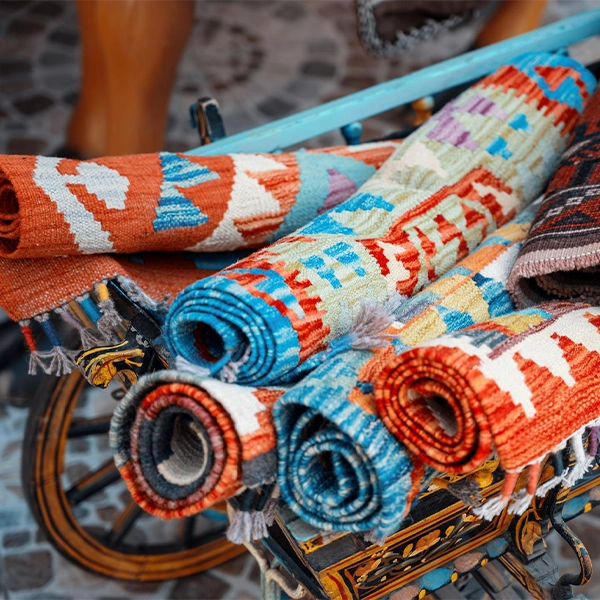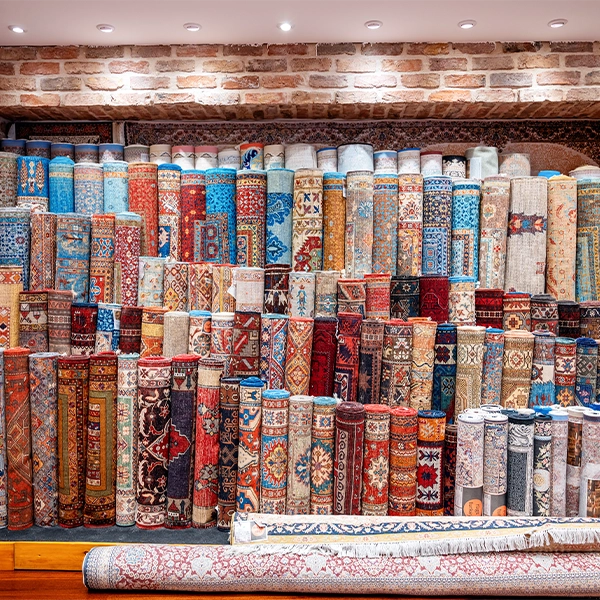handmade vs machine-made rugs:
Rugs have been a part of human history for centuries. From the intricate patterns of Persian carpets to the modern precision of machine-made rugs, they serve not just a functional purpose but also add elegance and personality to our living spaces. When choosing a rug, many homeowners face the question: handmade vs machine-made rugs—which is better?
This comprehensive guide explores the crucial differences between these two categories, helping you make an informed decision based on quality, durability, aesthetics, and budget.
What Is a Handmade Rug?
A handmade rug is crafted manually by skilled artisans who often follow traditional techniques passed down through generations. Each knot is tied individually, making the process labor-intensive but resulting in a one-of-a-kind creation.
Techniques of Handmade Rugs
- Hand-Knotted: This is the most prestigious method. Each knot is tied by hand, and the rug can take months or even years to complete.
- Hand-Tufted: Slightly less labor-intensive, these rugs involve using a tufting gun to insert yarn into a canvas backing.
- Flat Weave (Kilim): These are made without knots and have no pile, offering a thinner, reversible textile.
What Is a Machine-Made Rug?
Machine-made rugs are manufactured using power looms controlled by computers. These machines can produce rugs at a fast rate, following pre-designed templates with minimal human intervention.
Characteristics of Machine-Made Rugs
- Uniform patterns and stitching
- Produced quickly and in large quantities
- Often made from synthetic materials like polypropylene, nylon, or polyester
1. Design and Uniqueness
handmade vs machine-made rugs:
Handmade Rugs
Each handmade rug is a unique piece of art. Even if multiple weavers follow the same design, slight variations in knotting, dye absorption, and weaving technique ensure no two rugs are exactly alike.
Machine-Made Rugs
These rugs follow a programmed design, ensuring every copy is identical. While this ensures consistency, it lacks the individuality that handmade rugs provide.
2. Materials Used
handmade vs machine-made rugs:
Handmade Rugs
Traditionally, artisans use natural fibers such as:
- Wool
- Silk
- Cotton
These materials are known for their durability, softness, and natural sheen.
Machine-Made Rugs
Mostly synthetic materials are used for cost-efficiency:
- Polypropylene
- Polyester
- Nylon
While these materials are more stain-resistant and affordable, they may not have the same luxurious feel or longevity.
3. Durability and Lifespan
handmade vs machine-made rugs:
Handmade Rugs
Hand-knotted rugs can last for generations—some antique rugs have been preserved for centuries. The craftsmanship and natural fibers used ensure long-lasting quality.
Machine-Made Rugs
Typically, machine-made rugs last anywhere from 5 to 20 years, depending on usage and material. The glue or latex backing may deteriorate over time, reducing their lifespan.
4. Price and Investment Value
handmade vs machine-made rugs:
Handmade Rugs
Due to the labor and quality involved, handmade rugs tend to be more expensive. However, they can appreciate in value over time, especially antique or rare pieces.
Machine-Made Rugs
These are budget-friendly and ideal for homeowners looking to change styles frequently. However, they generally don’t hold or increase in value.
5. Production Time
handmade vs machine-made rugs:
Handmade Rugs
Creating a large hand-knotted rug can take several months to a year or more. The time reflects the attention to detail and skill required.
Machine-Made Rugs
Manufacturing is quick—most rugs are produced within a few hours to days. This speed allows mass production for commercial use.
6. Environmental Impact
handmade vs machine-made rugs:
Handmade Rugs
Natural fibers and dyes are biodegradable and eco-friendly. Handmade rug production also supports traditional craftsmanship and often involves sustainable practices.
Machine-Made Rugs
Synthetic materials and chemical dyes can contribute to environmental degradation. However, some manufacturers are moving toward eco-friendly production methods.
7. Maintenance and Cleaning
Handmade Rugs
Natural fiber rugs may require professional cleaning but are generally easy to maintain with proper care. Spot cleaning should be done carefully to avoid damaging the fibers.
Machine-Made Rugs
These rugs are often treated with stain-resistant chemicals, making them easier to clean at home. However, harsh chemicals can wear them down faster over time.
8. Cultural and Artistic Value
Handmade Rugs
These are often rich in cultural significance, especially those made in regions like Iran, India, Turkey, or Morocco. The designs often tell stories or represent tribal heritage.
Machine-Made Rugs
While they can replicate traditional designs, they lack the emotional and historical value that comes with handmade artistry.
9. How to Identify Each Type
If you’re trying to determine whether a rug is handmade or machine-made, here are some clues:
| Feature | Handmade Rug | Machine-Made Rug |
|---|---|---|
| Back of Rug | Knots are uneven and visible | Uniform stitching or latex/glue backing |
| Fringe | Part of the rug’s structure | Often sewn or glued on |
| Symmetry | Slight asymmetry in design | Perfect symmetry |
| Price | Higher | Lower |
| Origin | Often labeled with country/region | Usually factory-produced |
Which One Should You Choose?
The answer depends on your priorities:
- Choose a handmade rug if you value uniqueness, craftsmanship, long-term investment, and cultural richness.
- Opt for a machine-made rug if you’re budget-conscious, need something quickly, or frequently change your home decor.
Final Thoughts
The debate between handmade vs machine-made rugs isn’t about which one is better—it’s about what suits your needs, lifestyle, and appreciation for art and design. While handmade rugs offer unmatched quality and heritage, machine-made rugs provide affordability and convenience.
Whatever your choice, understanding the differences will help you make a purchase that adds comfort, style, and character to your home.



